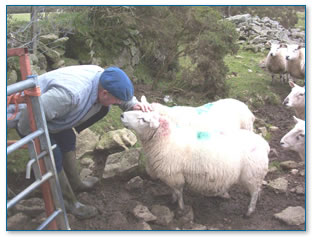sheep
dip
Sheep dip is used by farmers
to help prevent sheep from developing diseases like sheep scab and
against parasites that live on the sheep's body.
The sheep are dipped into a sunken
bath of liquid containing powerful chemicals.
 |
Sheep dip area |
Farmers have to take care when
they are mixing the sheep dip and when they empty the dipping bath
after all the sheep have been dipped. The chemicals used in sheep
dip can cause harm to human health and to the environment, especially
if they are disposed of in large quantities. Sometimes the old dip
is spread thinly over farmland, making sure that it does not get
into ditches or watercourses.
Disposal of sheep dip needs written
authorisation from the Environment Agency.

There are some ways that farmers can reduce the amount of chemicals
they use to protect sheep from nasty diseases:
 |
Shepherd and sheep |
There are alternatives to sheep
dip, such as pour-on solutions. This is a bit like giving the sheep
a shower instead of a bath, so less liquid containing powerful chemicals
is used. The farmer still has to make sure that the sheep do not
go into a stream when they have been 'showered' in case the chemicals
get into the water.
Sometimes injections can be given
to sheep to stop them getting some types of diseases. If a farmer
uses an alternative to sheep dip he or she has to be careful that
they are still able to protect their sheep properly against disease.
Keeping a close eye on a flock and controlling where the flock is
allowed to wander can help to avoid sheep getting diseases.
If sheep have to be dipped there
are other ways that farmers can reduce the amount of chemicals held
on the farm. By using equipment that does not waste any chemicals
and not ordering more than is needed, less dip would have to be
bought.
Chemicals entering the water
cycle can be a danger to the plants and animals that live in or
close to rivers and streams (B09)
and indeed all life that relies
on water to live.
|

